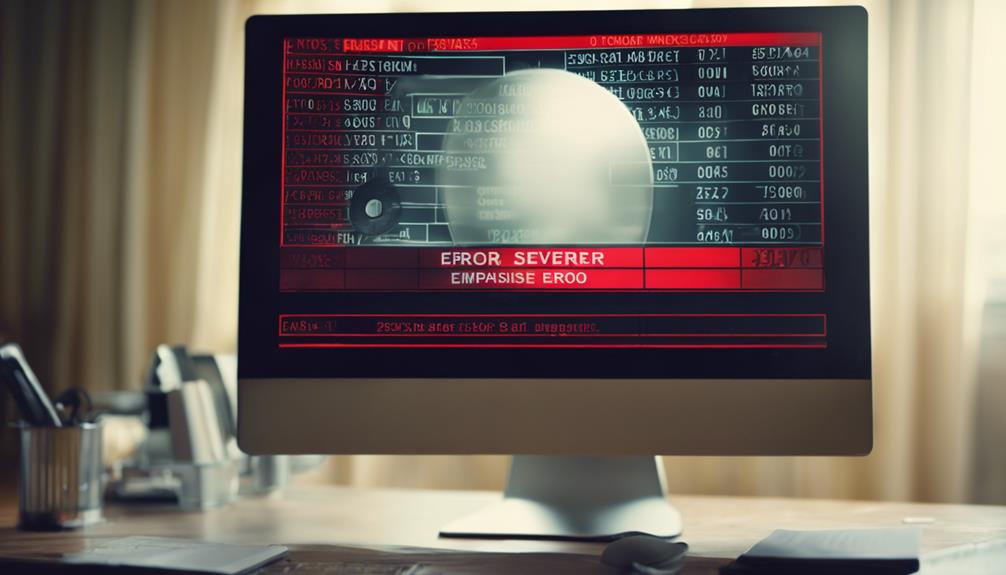When it comes to the intricate realm of web servers, the 5xx status codes stand out as crucial indicators of underlying issues that can disrupt the seamless operation of a website. Understanding the nuances of these server errors is not merely a technicality but a cornerstone of ensuring the reliability and performance of an online platform.
By comprehending the intricacies of 5xx errors, one can navigate the complexities of server management with precision and agility, ultimately safeguarding the digital presence from potential disruptions.
Overview of 5xx Server Errors

Understanding the intricacies of 5xx server errors is essential for ensuring the smooth functioning of web servers and maintaining optimal user experience. These errors, such as the 500 Internal Server Error, 502 Bad Gateway, 503 Service Unavailable, and 504 Gateway Timeout, signify issues on the server side that hinder the fulfillment of client requests.
When left unaddressed, 5xx errors can have detrimental effects on user experience, SEO performance, and even result in lost sales opportunities. Regularly monitoring and addressing these errors is crucial for the overall health of a website and its SEO performance.
Tools like ContentKing and Google Search Console are invaluable for promptly detecting and resolving 5xx errors before they escalate. By proactively managing 5xx server errors, web administrators can uphold the reliability and performance of their servers, ultimately ensuring a seamless and satisfactory user experience for visitors.
Importance of Resolving 5xx Errors
Promptly resolving 5xx server errors is paramount for enhancing user experience, safeguarding revenue streams, and maintaining the integrity of a website's SEO performance and credibility.
When 5xx errors occur, they disrupt the user journey, causing frustration and potentially leading to users abandoning the site. This can result in decreased traffic, conversions, and ultimately revenue loss.
Additionally, search engines penalize websites that frequently experience server errors, impacting their ranking and visibility. Failure to address these errors promptly can erode user trust and credibility, as visitors may perceive the site as unreliable or unprofessional.
Common 5xx Server Error Codes

Among the array of server errors that can impede smooth online experiences, common 5xx server error codes play a significant role in indicating specific issues hindering client request fulfillment. These error codes include 500 (Internal Server Error), 501 (Not Implemented), 502 (Bad Gateway), 503 (Service Unavailable), and 504 (Gateway Timeout).
Each of these codes signifies a different type of server-related problem that prevents the successful completion of client requests. Understanding these specific error codes is crucial as it aids in diagnosing and resolving server errors effectively. To resolve these issues, specific troubleshooting steps tailored to each error code are necessary.
Promptly monitoring and addressing these common 5xx errors is essential for maintaining the overall health of websites and ensuring a positive user experience. By recognizing and addressing these error codes promptly, website administrators can minimize downtime and prevent potential negative impacts on user satisfaction.
Causes of 5xx Errors
The occurrence of 5xx errors on servers can be attributed to various factors such as overloaded servers, coding errors, network connectivity issues, DDoS attacks, and software conflicts.
When servers are overloaded with more requests than they can handle, it can lead to 5xx errors. Additionally, coding errors in the server-side scripts or applications can cause malfunctions resulting in these errors.
Network connectivity issues, such as interrupted connections between the server and client, can also trigger 5xx errors. Moreover, Distributed Denial of Service (DDoS) attacks that flood servers with traffic beyond their capacity can overwhelm the system and generate 5xx errors.
Lastly, conflicts between different software components on the server can create instabilities leading to server failures. Understanding these root causes is crucial in effectively addressing and preventing 5xx errors to maintain website functionality and user satisfaction.
How to Detect 5xx Errors

Efficient detection of 5xx errors is essential for maintaining website health and ensuring optimal SEO performance. To identify pages returning 5xx errors on large websites, utilizing SEO crawlers such as Oncrawl, Ahrefs, or Moz proves to be effective. These tools offer comprehensive scans that can pinpoint problematic pages promptly.
Google Search Console is another valuable resource for revealing crawl errors related to 5xx server errors, although it may not provide real-time notifications like dedicated SEO crawlers. Detecting 5xx errors early is critical to resolve issues before search engines penalize the site. Swift identification through tools like SEO crawlers not only aids in addressing problems promptly but also helps in preserving website health and SEO performance.
Additionally, monitoring tools like ContentKing can offer real-time alerts, enabling immediate detection of 5xx errors on websites. Leveraging these tools ensures proactive error management and contributes to a seamless user experience.
Impact of 5xx Errors on SEO
Transitioning from understanding how to detect 5xx errors, it is imperative to grasp the significant impact these errors have on SEO performance. 5xx errors, such as 500 Internal Server Error or 503 Service Unavailable, can detrimentally affect a website's SEO efforts. These errors reduce the crawl budget allocated by search engines, hindering proper indexing of web pages. Consequently, pages that return 5xx errors may not rank or even be included in search engine results, limiting the site's visibility to potential visitors.
Furthermore, persistent 5xx errors can impede a website's ranking potential, even if it possesses high-quality content and valuable backlinks. Search engines like Google may penalize sites with recurring 5xx errors by demoting their rankings or excluding affected pages from search results. Therefore, promptly resolving 5xx errors is vital for maintaining website health, optimizing SEO performance, and ensuring a positive user experience.
Resolving 5xx Server Errors

To effectively address 5xx server errors, proactive monitoring and timely error resolution are essential components of maintaining a stable and reliable website infrastructure. Resolving these issues involves diligently checking server logs to pinpoint detailed error insights that can aid in identifying the root cause of the problem.
Additionally, monitoring server performance metrics is crucial for promptly detecting and addressing 5xx errors before they escalate. Updating software and plugins regularly is another key step in mitigating 5xx server failures and enhancing overall website stability.
Implementing robust security measures is fundamental in preventing and effectively resolving 5xx errors, safeguarding the website against potential vulnerabilities. In complex scenarios, seeking assistance from the web hosting provider can provide valuable support and expertise in resolving challenging 5xx server errors efficiently.
Best Practices for Fixing 5xx Errors
Addressing 5xx errors effectively requires a systematic approach that prioritizes proactive maintenance and continual monitoring of server performance. Timely resolution of these errors is vital as they can lead to revenue loss and impact SEO rankings.
Regular website maintenance, which includes software updates and security audits, plays a crucial role in preventing 5xx errors from occurring. Implementing caching mechanisms and utilizing content delivery networks can also help reduce the frequency of these server errors.
Monitoring server performance metrics and staying up to date with software and plugin updates are essential steps in resolving 5xx errors promptly. Additionally, reaching out to the web hosting provider for support can assist in quickly addressing and resolving any 5xx server failures that occur.
Frequently Asked Questions
What Is 5xx Server Error Code?
A 5xx server error code indicates a problem on the server side that prevents it from fulfilling a request. It signifies issues like internal server errors, bad gateways, service unavailability, and gateway timeouts, impacting user experience, SEO, and sales.
What Is the Status Code 2xx?
The status code 2xx in HTTP signifies a successful request. Codes like 200 (OK), 201 (Created), and 204 (No Content) indicate successful processing, creation of a new resource, or a request with no content returned, respectively.
What Does the HTTP Status Code 1xx 2xx 3xx 4xx 5xx Denote?
HTTP status codes are grouped into categories like 1xx, 2xx, 3xx, 4xx, and 5xx to signify the nature of the response. 1xx-5xx denote informational, success, redirection, client error, and server error statuses, respectively, aiding in troubleshooting web communication issues.
What Is Error 4xx or 5xx?
Error 5xx indicates server-side issues impacting request fulfillment. It denotes problems within the server, not the client's request. Common examples include 500 for internal server error and 503 for service unavailability. Prompt resolution is critical for website health.
Conclusion
In conclusion, understanding and addressing 5xx server errors is essential for website maintenance and SEO performance. By promptly resolving these issues, businesses can ensure a seamless user experience, avoid potential sales losses, and maintain a strong online presence.
Monitoring tools, analysis of server logs, and swift action are key components in effectively managing and mitigating 5xx errors to ensure the overall health and functionality of a website.

